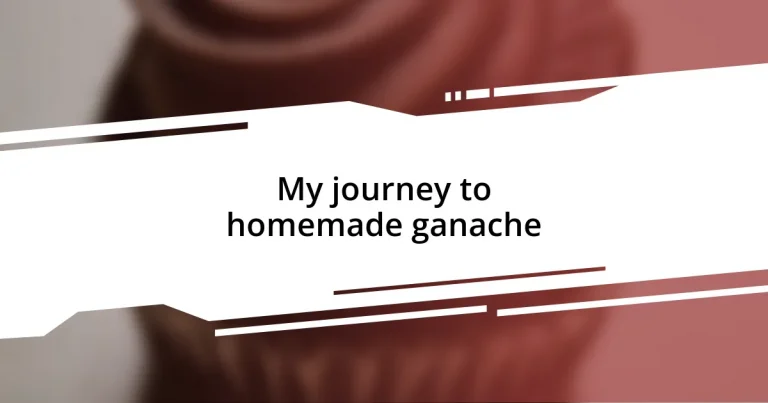Key takeaways:
- Ganache consists of chocolate and cream, with ratios affecting its texture and flavor: 1:1 for dipping, 2:1 for frosting.
- High-quality ingredients are essential; use superior chocolate and fresh cream for the best flavor.
- Control temperature during cream heating and mixing to prevent graininess; patience is key for perfect results.
- Experiment with different chocolates and flavorings (e.g., spices, citrus) to create unique ganache variations.
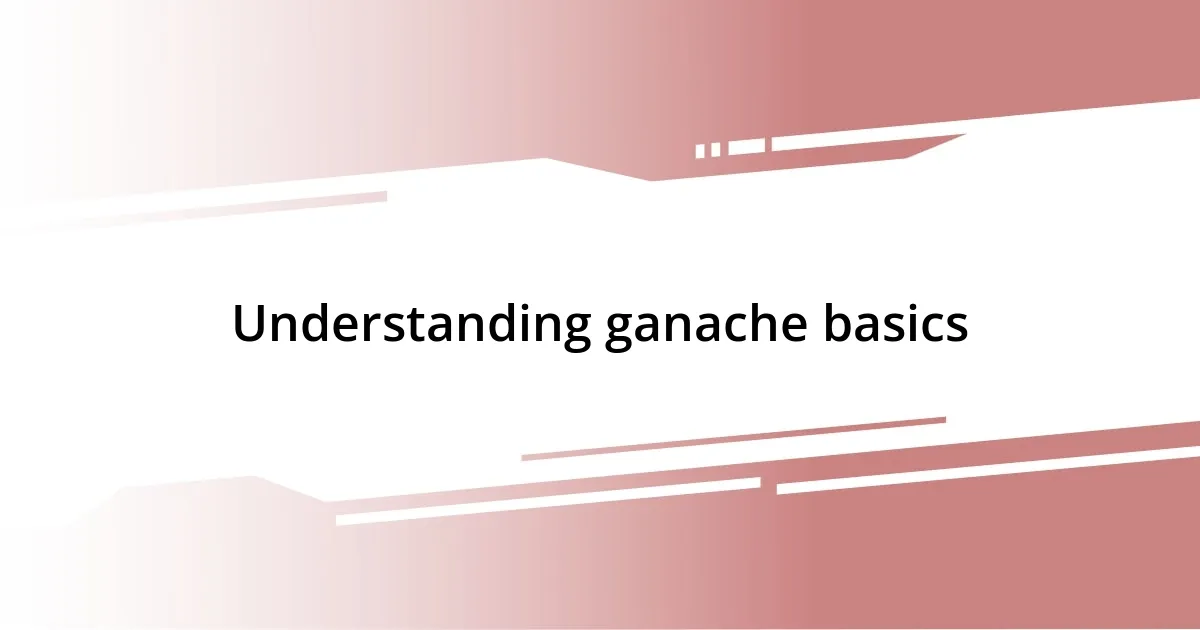
Understanding ganache basics
Ganache is a magical mixture of chocolate and cream, and understanding this simple yet versatile blend is key to unlocking various culinary creations. I still remember the first time I tried making ganache; it was an exhilarating mix of anticipation and curiosity as I watched the chocolate melt and meld with the cream, transforming into a silky, glossy delight. Have you ever felt that thrill of creating something from scratch and having it turn out beautifully?
The ratios of chocolate to cream can dramatically change the texture and flavor of your ganache. For instance, a 1:1 ratio is perfect for dipping or glazing, while a 2:1 ratio creates a thick, spreadable frosting. I often experiment with different chocolate types—dark, milk, and even white—each offering its unique twist. Isn’t it fascinating how something so basic can unleash so many possibilities for desserts?
When making ganache, temperature plays an incredibly important role. Warm cream helps the chocolate to melt evenly, preventing graininess, which I’ve learned the hard way! It’s a small detail, but it can make or break your ganache experience. Isn’t it amazing how a few ingredients and some attention can create such depth of flavor in your baking?
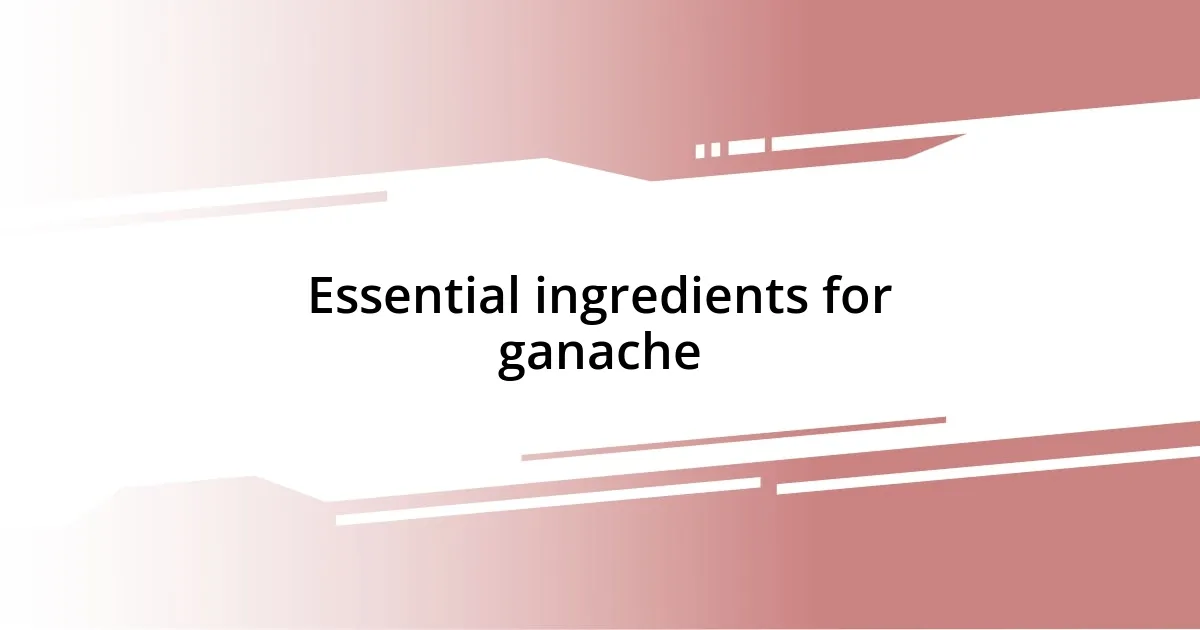
Essential ingredients for ganache
When I first ventured into the world of ganache, I was surprised to see how just a few ingredients could create something so decadent. The duo of chocolate and cream is at the heart of this treat, but the specific types and quality of each can significantly alter the final product. I’ve discovered that using high-quality chocolate truly elevates the flavor, making even a simple dessert feel gourmet.
Here’s a quick rundown of the essential ingredients for making ganache:
- Chocolate: Choose between dark, milk, or white chocolate based on your desired sweetness and richness.
- Heavy Cream: This is crucial for creating that smooth, luscious texture that ganache is known for.
- Optional Add-ins: You might explore flavors like vanilla extract, espresso, or even a splash of liqueur for a unique twist.
On one occasion, I decided to experiment with some leftover dark chocolate from a baking project, and it turned out to be one of my best culinary decisions. The ganache was rich and velvety, perfect for glazes and truffles. I still get a smile on my face thinking about that first luscious bite!

Tools needed for making ganache
When embarking on my journey to make ganache, I quickly realized that having the right tools can make all the difference. You’ll want a heatproof mixing bowl that can handle the warmth of melted chocolate without warping. I still remember using a regular bowl and panicking when it began to lose shape—definitely not a good day in the kitchen! Additionally, a whisk or spatula is essential; I’ve found that a silicone spatula gives me greater control, especially when I’m trying to scrape every last bit of ganache from the sides of the bowl.
Next on the list should be a kitchen scale for precise measurements. Early on, I relied on cups and spoons, but let me tell you, weighing your ingredients leads to consistent results every time. There’s something so satisfying about accurately measuring chocolate and cream, knowing that my ganache will turn out just right. I’ve had instances where my ganache was off due to improper ratios, and trust me, it’s worth investing in good tools for the best outcomes!
| Tool | Purpose |
|---|---|
| Heatproof Mixing Bowl | For mixing and melting the chocolate and cream safely. |
| Whisk or Spatula | To blend ingredients smoothly and scrape the bowl clean. |
| Kitchen Scale | For accurate measurements, ensuring perfect ratios of chocolate and cream. |
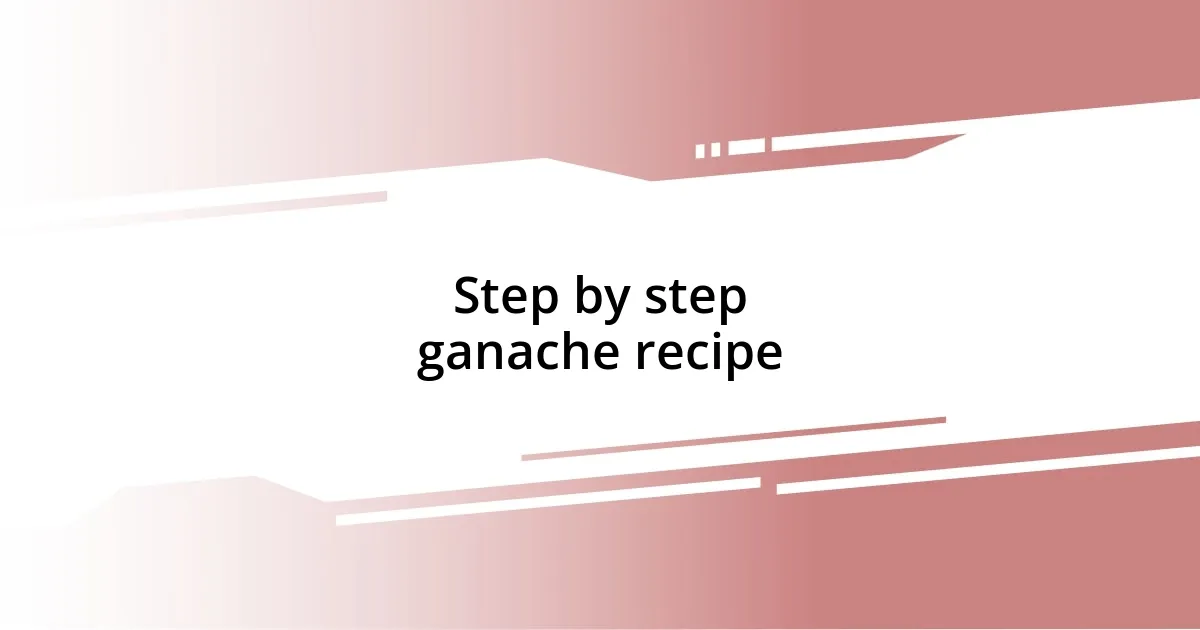
Step by step ganache recipe
The first step in making ganache is to chop your chocolate into small, even pieces. This might sound simple, but I remember my first attempt; I was so eager that I ended up with uneven chunks. The smaller pieces melt more uniformly, which is essential for achieving that silky texture we all crave in ganache. I often find myself savoring the smell of chocolate as I chop—there’s something so enticing about it.
Next, heat the cream gently until it begins to simmer, but don’t let it boil. I learned this the hard way when I scorched my cream once; it was a lesson that reinforced the importance of patience in the kitchen. Once the cream is ready, pour it over the chopped chocolate, allowing it to sit for a few minutes. This moment, while waiting for the magic to happen, always gets me excited—a sort of anticipation that never fades.
Finally, once the chocolate has softened, grab your whisk or spatula and gently stir until everything is combined and glossy. I still remember my joy the first time I saw that transformation—the lump of chocolate and cream evolving into a smooth, luscious ganache. It’s as if you’re witnessing a culinary alchemy! And here’s a tip: If your ganache appears too thick, you can always add a touch more warm cream to adjust the consistency. What’s your perfect ganache texture? I find I often go for a softer finish, perfect for drizzling over desserts.
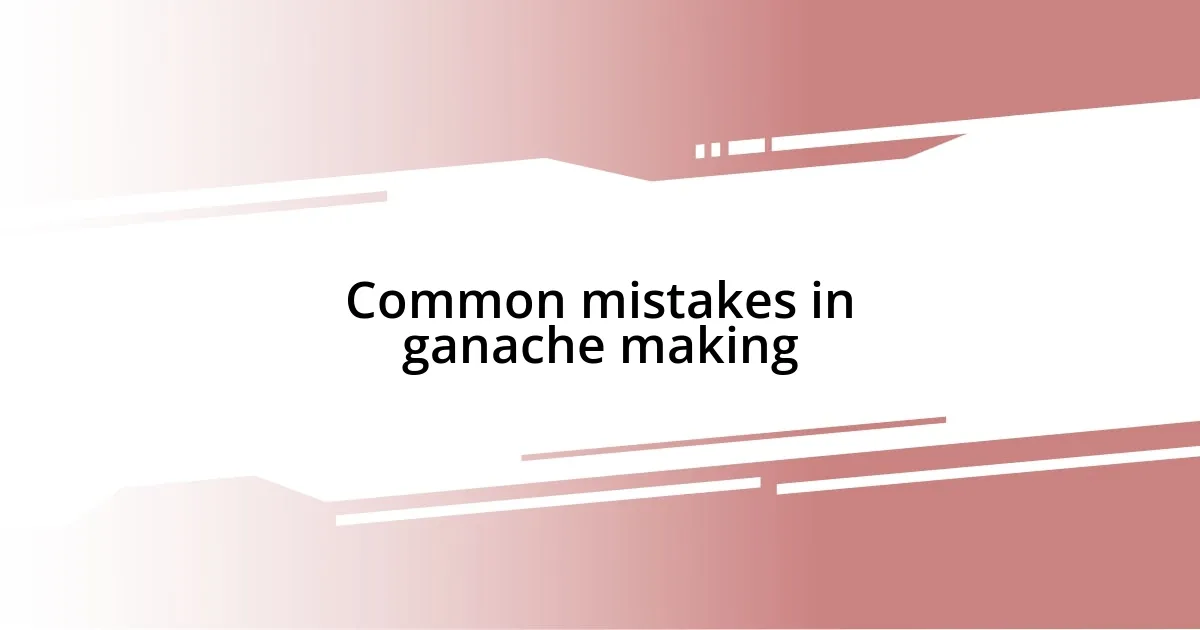
Common mistakes in ganache making
One common mistake I often see is not using the right chocolate. When I first experimented with ganache, I grabbed whatever chocolate I had on hand, thinking a basic chocolate bar would suffice. However, the quality of chocolate greatly impacts the flavor and texture of the ganache. I learned that premium chocolate not only melts beautifully but also delivers a richer taste. Do you ever wonder why some desserts taste heavenly while others fall flat? It often comes down to the ingredients used.
Another frequent pitfall is overheating the cream. I made this error more times than I’d like to admit! My first few batches ended up with a burnt taste because I didn’t know when to take the cream off the heat. Now, I know to watch for those tiny bubbles forming around the edges of the pan—this signals it’s ready for the chocolate. Trust me, it’s a game-changer when you realize that patience pays off in the kitchen.
Lastly, improper mixing can ruin that silky texture we all strive for. I recall a time when I whisked my ganache too vigorously, incorporating too much air and making it grainy. It was a disappointing moment! Now, I gently fold the chocolate and cream mixture together, allowing the ganache to achieve that velvety consistency I adore. Have you ever had a dish that just didn’t turn out as you’d hoped? Sometimes, it’s the little details that make all the difference in a recipe.
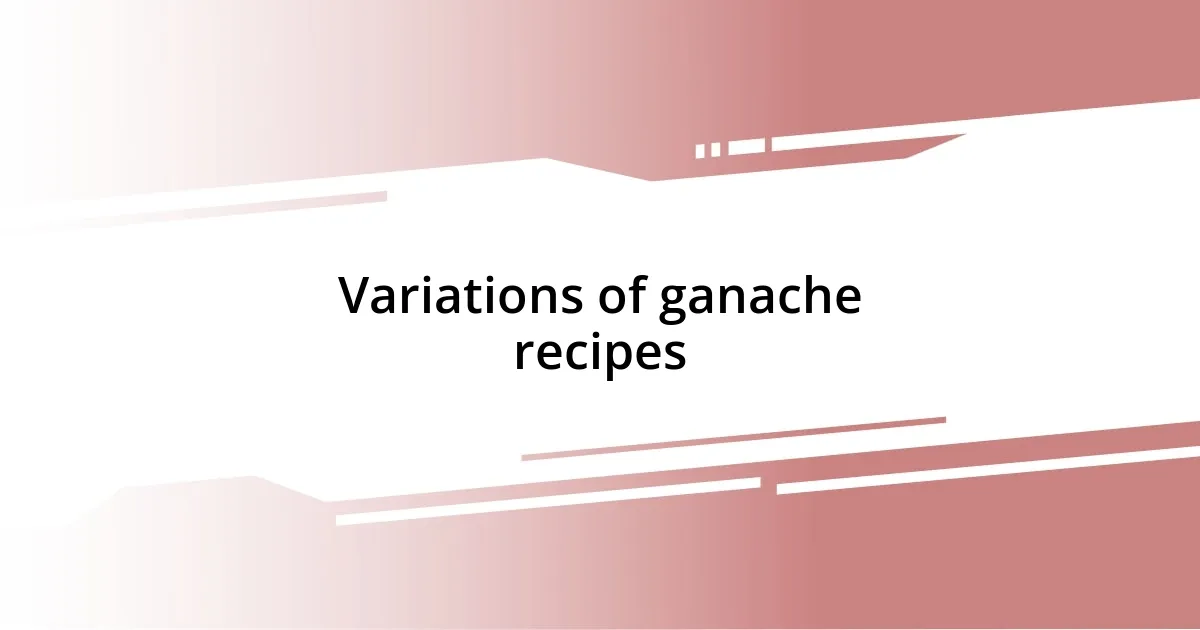
Variations of ganache recipes
When it comes to ganache, the beauty lies in its versatility. I often switch out the chocolate type depending on my mood. One of my favorites is using dark chocolate for a rich, intense flavor, but milk chocolate can create a sweeter, creamier ganache that’s perfect for topping cupcakes. Have you ever experimented with different types of chocolate? Each kind brings its own unique character to the dessert.
Beyond chocolate, flavoring your ganache can be a delightful twist! I remember trying orange zest once—what a revelation that was! The citrus notes paired beautifully with dark chocolate, adding a refreshing lift to an otherwise heavy texture. You can also infuse the cream with spices like cinnamon or even add flavored extracts such as peppermint or vanilla. It’s amazing how a small adjustment can create an entirely different experience.
Another variation I’ve grown fond of is incorporating different fats, such as butter or coconut oil. When I first tried adding a bit of butter to my ganache, it created an extra level of glossiness that made the surface shine. And for those interested in a dairy-free version, coconut oil can be an excellent substitute, imparting a subtle tropical flavor. Have you ever thought about how simple substitutions can elevate your ganache game? Exploring these variations has truly expanded the way I view this classic recipe.
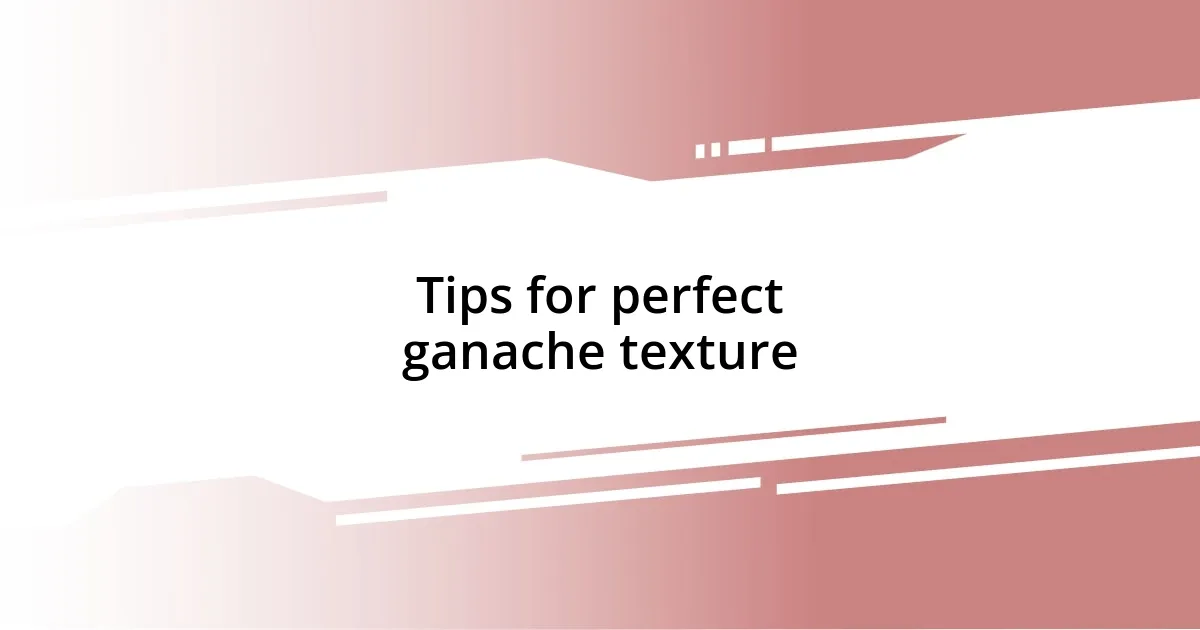
Tips for perfect ganache texture
When it comes to achieving that perfect ganache texture, my experience has taught me the importance of the proper chocolate-to-cream ratio. I remember my first attempts where I was a bit heavy-handed with the chocolate, and the ganache turned out too thick. Now, I stick to a classic 2:1 ratio for dark chocolate—this ensures a luscious texture that melts in the mouth. Have you ever found the right balance in your cooking that made all the difference?
Another way to enhance ganache texture is through temperature control. I once let my ganache cool too quickly in the fridge, and it became stiff and unspreadable. To avoid this, I learned to let it cool at room temperature before refrigerating. This slow cooling helps maintain that creamy consistency that’s so sought after. It’s fascinating how such a simple tweak can elevate the overall quality, wouldn’t you agree?
Lastly, don’t underestimate the impact of patience while mixing. There was a time when I couldn’t wait to dive into my freshly made ganache and ended up overmixing. This resulted in a grainy texture that had me feeling disheartened. Now, I take my time to gently stir, allowing the mixture to blend seamlessly. It’s almost meditative, and I often remind myself that good things come to those who wait—particularly in baking!












